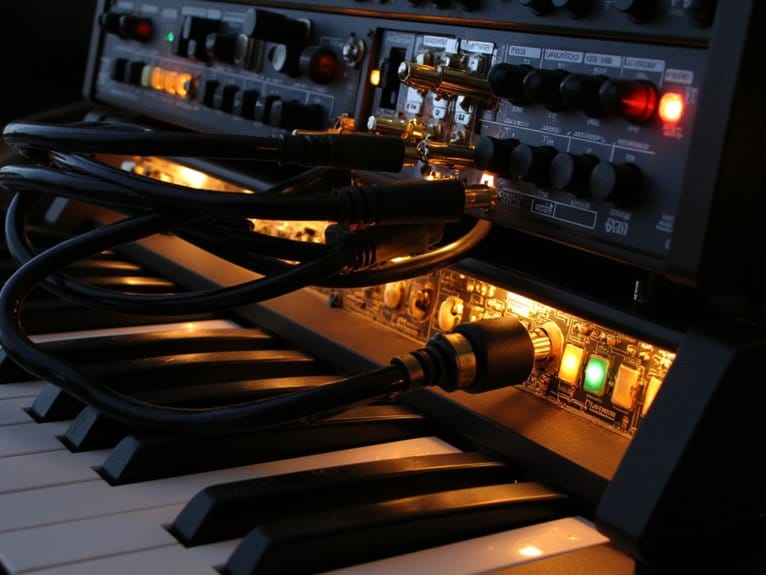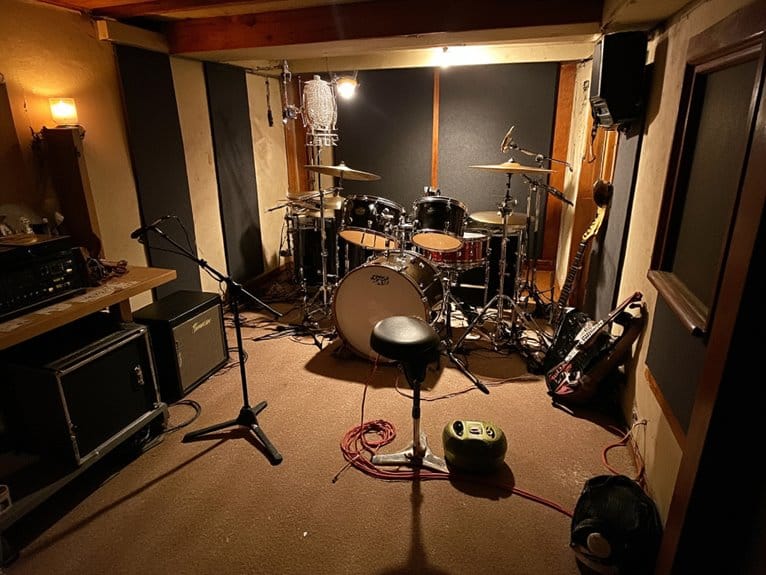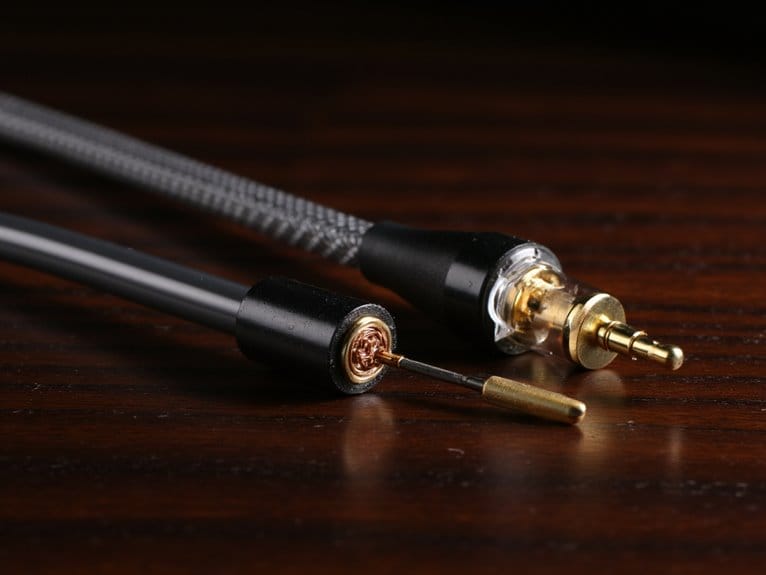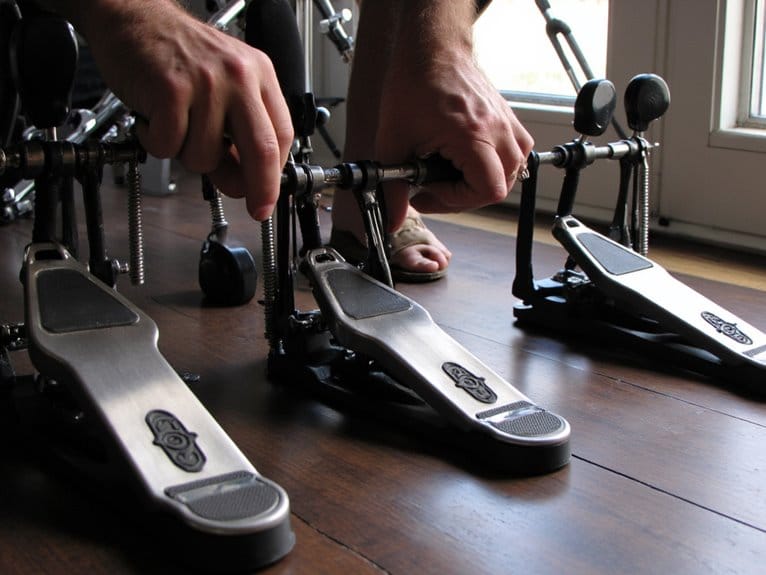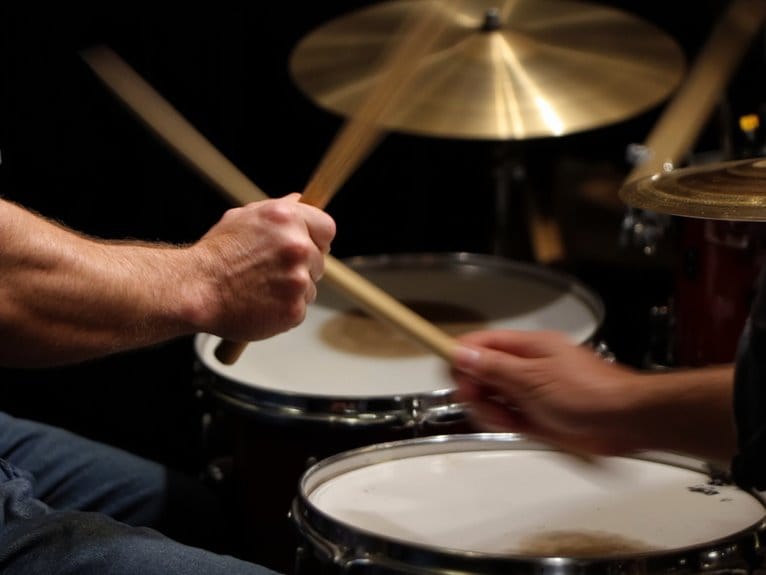Understanding MIDI Implementation in Keyboards and Synths
MIDI implementation transforms your keyboard into a powerful communication hub that transmits musical data at 31,250 bits per second across 16 independent channels, enabling real-time control of synthesizers, computers, and sound modules through standardized messages like Note On/Off, Control Change, and Program Change commands. You’ll connect via traditional 5-pin DIN ports for legacy compatibility or USB for plug-and-play functionality, while advanced features like NRPN provide 14-bit resolution for precise parameter control that reveals deeper creative possibilities.
We are supported by our audience. When you purchase through links on our site, we may earn an affiliate commission, at no extra cost for you. Learn more.
Notable Insights
- MIDI transmits musical data at 31,250 bits per second across 16 channels, connecting keyboards, computers, and sound modules without sending audio signals.
- Note On/Off, Control Change, Program Change, and Pitch Bend messages enable real-time control of synthesizer parameters and sound triggering.
- Monophonic synthesizers excel at bass and leads while polyphonic synths offer complex voice allocation for richer harmonic textures.
- NRPN provides 14-bit resolution control using four CC messages, enabling precise adjustment of advanced synthesis parameters like filter depth.
- Modern controllers feature touch-sensitive knobs, aftertouch, and MPE capabilities for expressive per-note control and dynamic sound manipulation.
MIDI Fundamentals and Communication Standards
The backbone of modern electronic music production lies in a deceptively simple yet powerful communication standard that I’ve watched transform the industry since its inception in the early 1980s.
MIDI basics center around a protocol that transmits musical data at 31,250 bits per second using short messages, typically one to four bytes long. This MIDI protocol enables device addressing through 16 independent MIDI channels per port, allowing multiple instruments to communicate simultaneously on a single connection.
General MIDI standardization guarantees MIDI compatibility across manufacturers by defining consistent instrument mappings and minimum polyphony requirements. Through these communication standards, MIDI interoperability has become the foundation that connects your keyboard, computer, and sound modules into a cohesive musical ecosystem. The protocol operates by sending data messages that describe musical actions rather than transmitting actual audio signals, making it an efficient system for real-time musical control.
MIDI’s versatility extends beyond musical performance to control applications like stage lighting systems and event triggering for multimedia productions.
Essential MIDI Message Types and Their Functions
When you’re working with MIDI devices, you’ll encounter several core message types that form the backbone of digital music communication, each serving specific functions that control how your instruments respond to performance data.
The fundamental messages include Note On and Note Off commands that trigger and release sounds, Control Change messages that adjust parameters like volume and modulation in real-time, and Program Change instructions that switch between different instrument patches or presets. These basic commands also include velocity encoding that represents the speed at which keys are pressed, with values ranging from 0 to 127 based on MIDI’s 7-bit value system.
Beyond these standard messages, you’ll also work with System Exclusive data, which allows manufacturers to transmit device-specific information that extends beyond MIDI’s universal command set, enabling deep parameter editing and custom functionality that varies between different brands and models.
Core MIDI Messages
Communication between MIDI devices relies on a structured vocabulary of digital messages, each serving specific functions that transform your keyboard presses, knob turns, and pedal movements into data that synthesizers can understand and respond to.
These MIDI message types form the foundation of digital music communication protocols, enabling precise control over every aspect of sound generation and manipulation.
The core MIDI data formats encompass several essential categories:
- Note On/Off messages – Control when notes start and stop, including velocity data from 0-127 that determines volume and timbre based on how hard you press keys
- Aftertouch functions – Send continuous pressure data after initial key press, allowing expressive modulation of parameters like vibrato or filter cutoff during sustained notes
- Control Change applications – Modify synthesizer parameters including volume, pan, modulation wheel, and sustain pedal through 128 possible controller assignments
Pitch Bend usage provides smooth pitch modulation with 14-bit resolution, while Program Change features enable instant instrument switching.
System Exclusive Data
Beyond standard MIDI’s core message types lies a powerful, manufacturer-specific communication protocol that releases the full potential of your synthesizers and samplers through System Exclusive (SysEx) data. SysEx formats begin with 0xF0, followed by manufacturer-specific messages or universal messages for cross-brand compatibility, enabling extensive patch management and device addressing through unique IDs.
While SysEx applications include transmitting entire sound banks and detailed parameter changes, you’ll encounter SysEx challenges like MIDI bus congestion during active playback, requiring careful timestamp considerations to maintain data integrity.
I’ve learned that proper device addressing prevents multiple units from responding simultaneously, though debugging proprietary formats demands manufacturer documentation. Despite these complexities, SysEx remains indispensable for accessing your instrument’s full feature set beyond basic performance data.
Parameter Control Through CC Messages and NRPN
When you’re ready to take your MIDI control beyond basic note-on and note-off messages, Control Change (CC) messages become your primary tool for manipulating synthesizer parameters like volume, filter cutoff, and reverb depth in real-time.
You’ll find that standard CC messages, with their 128 controller numbers and 0-127 value range, handle most common parameter adjustments quite well, though they’re sometimes limited by their 7-bit resolution when you need ultra-smooth parameter sweeps.
For those moments when standard CC messages aren’t quite enough, NRPN (Non-Registered Parameter Number) messages offer expanded control possibilities, giving you access to manufacturer-specific parameters and higher resolution control through clever combinations of multiple CC messages.
CC Message Basics
While most musicians intuitively understand that pressing keys harder or softer affects sound dynamics, I’ve found that mastering MIDI Control Change (CC) messages reveals a much deeper level of expressive control over your electronic instruments.
The CC message structure follows a simple format: status byte (0xB0 plus channel), controller number (0-127), and value (0-127). This CC value range gives you precise parameter control, though I’ll admit the 128-step resolution initially felt limiting until I realized how smoothly it translates to real-world adjustments.
Key aspects you’ll encounter include:
• Custom CC assignments for device-specific parameters using undefined controller numbers
- CC automation techniques that transform static sounds into dynamic, evolving textures
- Standard mappings like CC1 for modulation, CC7 for volume, and CC64 for sustain pedal functionality
- CC automation techniques that transform static sounds into dynamic, evolving textures
Modern synthesizers like the Arturia MiniFreak demonstrate sophisticated MIDI connectivity through their comprehensive control change implementation across multiple synthesis engines. Just as drum hardware packs offer memory locks to prevent parameter drift during performances, many MIDI controllers feature similar mechanisms to maintain your CC assignments across different sessions and venues.
NRPN Advanced Control
Four additional Control Change messages working together enable NRPN (Non-Registered Parameter Number) functionality, which I’ve discovered provides the precise 14-bit control resolution that standard CC messages simply can’t deliver.
Controllers 99 and 98 select your parameter address, while CC 6 and 38 transmit the actual value data, creating sophisticated NRPN parameter mapping capabilities that extend far beyond basic automation.
NRPN utility examples include filter envelope depth, LFO frequencies, and unison modes that demand finer resolution than 128 steps.
However, NRPN programming challenges arise from the complexity of splitting MSB/LSB values and interpreting manufacturer-specific assignments.
While NRPN device compatibility varies greatly between brands, and NRPN performance impact increases MIDI traffic considerably, the NRPN benefits overview clearly demonstrates superior control precision for advanced synthesis parameters.
Modern 61-key MIDI controllers like the Novation 61SL MkIII and Arturia KeyLab Essential mk3 implement these advanced NRPN protocols through their comprehensive DAW integration systems.
MIDI Connectivity Options and Port Configuration
Three primary MIDI port types form the backbone of electronic music connectivity, and understanding their differences will save you countless hours of troubleshooting when you’re trying to link your gear together.
Understanding MIDI port differences will save you countless hours of troubleshooting when connecting your electronic music gear together.
Traditional 5-pin DIN connections remain essential for legacy compatibility with older synths, while USB MIDI offers plug-and-play advantages with computers and faster data transfer rates.
Your MIDI routing strategies depend heavily on interface considerations and the complexity of your multi device setups:
- USB connections provide direct computer integration but may require adapters for hardware synths
- DIN ports enable daisy chain connections through MIDI Thru for signal distribution to multiple instruments
- Channel configurations allow selective control over 16 different MIDI channels per port for organized routing
Proper port selection guarantees seamless communication between your controllers and sound modules.
Synthesizer Types and Their MIDI Capabilities
When you’re selecting synthesizers for your MIDI setup, understanding how different synth architectures handle MIDI data becomes essential for making informed purchasing decisions and optimizing your workflow.
Monophonic synthesizers excel at bass lines and lead sounds, offering straightforward MIDI implementation with basic note data and control changes, though they lack extensive voice allocation since they’re designed for single-note performance. Polyphonic synthesizers provide complex voice allocation systems that distribute MIDI notes across multiple voices, enabling rich chord progressions and layered textures.
| Synthesizer Type | MIDI Capabilities | Best Use Cases |
|---|---|---|
| Monophonic | Basic CC mapping, sequencing | Bass, leads, arpeggios |
| Polyphonic/Hybrid | Multi-timbral, advanced parameter mapping | Chords, complex sound design |
| Software Synths | Unlimited CC assignment, flexible routing | Studio production, performance features |
Hybrid synthesizers combine analog warmth with digital precision, typically offering thorough parameter mapping and multi-channel MIDI support, while MIDI modules prioritize low-latency performance over programmability, and software synths deliver virtually unlimited sequencing capabilities. Modern synthesizers benefit from 24-bit/192kHz recording quality when connected to professional audio interfaces, ensuring pristine capture of your MIDI-triggered sounds. When integrating these synthesizers with your recording setup, consider audio interfaces with MIDI connectivity like the Arturia MiniFuse series to ensure seamless communication between your hardware and software components. Professional studio monitoring requires attention to frequency response characteristics, as synthesizers typically operate across the full 20Hz-20kHz spectrum for optimal sound reproduction.
Advanced MIDI Features and Implementation
Beyond selecting the right synthesizer architecture for your MIDI setup, the real power emerges when you harness advanced MIDI features that transform basic note-on messages into nuanced, expressive performances.
I’ve found that mastering these sophisticated capabilities separates casual players from serious musicians who demand professional-grade control over their sound.
Modern MIDI performance techniques release extraordinary creative possibilities through:
- Touch-sensitive knobs and pressure-sensitive pads that enable real-time parameter manipulation and dynamic triggering
- Aftertouch implementation that sends continuous control messages for vibrato, filter sweeps, and expressive modulation
- MPE (MIDI Polyphonic Expression) support providing per-note control of pitch, timbre, and expression for organic performance feel
MIDI sound layering configurations allow you to trigger multiple instruments simultaneously, creating complex textures while maintaining playability through customizable zone splits and multi-timbral voice allocation across different channels.
Optimizing MIDI Setup for Different Musical Applications
Every successful MIDI setup demands careful optimization that aligns with your specific musical goals, whether you’re crafting intricate studio productions, delivering high-energy live performances, or exploring creative soundscapes across different genres.
Your MIDI mapping strategies should reflect these distinct applications, customizing controller assignments to match genre-specific requirements like complex effect control for EDM versus expressive velocity sensitivity for jazz synthesis.
I’ve found that multiple MIDI devices expand control surfaces considerably, accommodating layered arrangements while maintaining workflow efficiency.
Genre adaptations become essential when adjusting configurations between studio sequencing and live improvisation scenarios.
You’ll want to leverage MIDI’s non-destructive editing capabilities for safe experimentation, while exploiting its low file sizes for managing multiple tracks without taxing system resources unnecessarily.
Frequently Asked Questions
Can I Use Multiple MIDI Keyboards Simultaneously With One Computer?
You can definitely use multiple MIDI keyboards simultaneously with one computer. MIDI controller compatibility allows multi keyboard setup through USB hubs, MIDI interfaces, or daisy chaining, provided you configure unique channels.
How Do I Fix MIDI Latency Issues During Live Performance?
You’ll fix MIDI latency by lowering your audio buffer size, using ASIO drivers, and employing MIDI troubleshooting techniques like optimizing performance settings, minimizing device chains, and choosing wired connections over wireless.
What Causes MIDI Notes to Get Stuck and How to Prevent It?
You’ll experience stuck notes when Note On commands send without corresponding Note Off messages, often from faulty cables, excessive MIDI data, or sustain pedal issues exceeding note polyphony limits, so use quality connections and filter unnecessary data.
On a final note
You’ve now got the foundation to tackle any MIDI setup, whether you’re connecting a simple controller to your DAW or building a complex multi-synth rig. Don’t expect perfection immediately—MIDI can be finicky, and even experienced producers occasionally spend hours troubleshooting mysterious note conflicts or timing issues. Start with basic connections, experiment with CC mappings, and gradually incorporate advanced features like NRPN control as your confidence grows.

